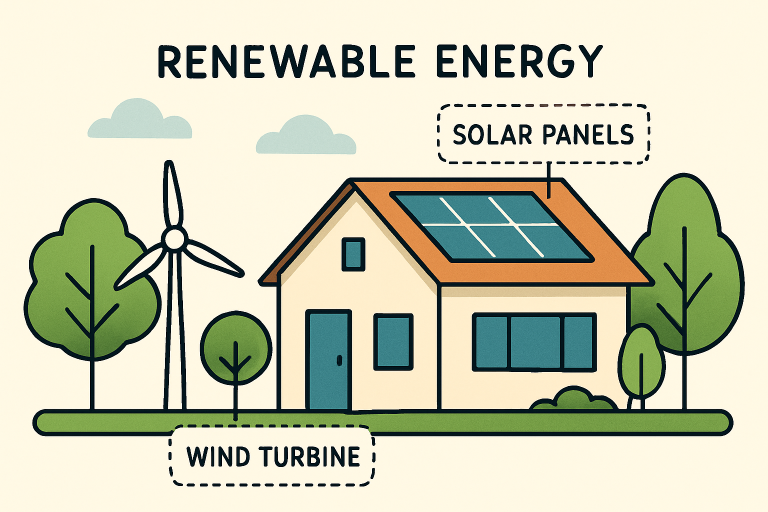Key Takeaways
- Implementing renewable energy sources can significantly lower energy bills and reduce carbon footprints.
- Energy-efficient appliances and smart home technologies enhance sustainability and convenience.
- Government incentives and programs support the transition to sustainable energy solutions.
As the need for environmental responsibility grows, households are increasingly considering how they can make an impact while enjoying practical benefits. An essential element of this shift is the adoption of sustainable energy solutions, which not only help lower day-to-day expenses but also promote a greener future. For those considering this transition, researching the best solar panel companies can be a smart first step toward harnessing the sun’s abundant energy and dramatically reducing reliance on nonrenewable sources. Embracing eco-friendly household energy strategies not only lowers utility bills but also reduces carbon footprints, benefiting the environment. Solutions vary per home, including renewable energy sources such as solar and wind, energy-efficient appliances, and smart home systems. Homeowners can combine these to decrease reliance on fossil fuels, achieve long-term savings, and enhance comfort. With government incentives and local initiatives, clean, affordable energy access is improving for all types of households. Upgrading energy profiles empowers homeowners by enabling them to control their consumption and fostering security and independence.
Renewable Energy Integration
For homeowners seeking immediate and long-term benefits, integrating renewable energy systems is a pivotal first move. Solar panels are a leading choice, providing clean power directly from the sun and offering substantial energy bill reductions after the initial investment. According to the U.S. Department of Energy, solar power not only pays off in the long run but also increases home values in many regions. Small wind systems are another notable option. If your home is located in a region where average wind speeds reach at least 9-10 mph, wind turbines can cut your electricity bills by 50-90%. These systems are ideal for rural or semi-rural properties with consistent wind access and ample space. Local zoning regulations, noise considerations, and the surrounding landscape will all impact the feasibility and performance of home wind solutions, making a site-specific assessment advisable. For more detailed guidance, visit the U.S. Department of Energy’s resources on home energy systems.
Energy-Efficient Appliances
Shifting to energy-efficient appliances is an effective way to boost your home’s sustainability with relatively little upfront effort. Look for products carrying the ENERGY STAR label, which signifies compliance with stringent efficiency requirements. For example, ENERGY STAR refrigerators use approximately 9% less energy than standard models, resulting in consistent savings. Similarly, ENERGY STAR washing machines not only use less electricity but also conserve water, providing dual environmental benefits. By replacing outdated appliances with certified alternatives, households can quickly reduce both utility costs and overall energy consumption.
Read Also: Solar Energy for Everyday Homes: A Practical Guide
Smart Home Technologies
Today’s smart home technologies are designed to maximize convenience while optimizing household energy consumption. Devices such as smart thermostats use artificial intelligence and learning algorithms to fine-tune heating and cooling schedules based on occupant behavior and local weather data. This targeted energy use can lower heating and cooling costs by up to 10-15% per year. Furthermore, intelligent lighting systems offer automation features such as scheduling, remote control via mobile apps, and occupancy sensors that can detect when a room is empty. This minimizes unnecessary illumination, reducing wasted electricity and lowering monthly bills. Beyond lighting and climate control, many smart appliances and power strips offer insights into usage patterns, enabling users to make data-driven decisions for improved efficiency.
Government Incentives and Programs
Homeowners can accelerate their move toward sustainability by leveraging government programs that encourage energy efficiency. For example, the U.S. Department of Housing and Urban Development (HUD) and the U.S. Department of Agriculture (USDA) have both updated their energy codes, benefitting millions of households in government-assisted housing. These changes are projected to save residents nearly $950 annually while also reducing overall demand for grid-based electricity. Federal tax credits, state-level rebates, and local utility incentives are also available to offset the costs of upgrades ranging from insulation to renewable system installations. Staying Informed about local and national incentive programs can substantially lower the initial investment in sustainable technology, making it more accessible for a wide range of families.
Community Initiatives
In addition to individual action, community-based initiatives are proving to be powerful plays in driving sustainable change. A recent study in Amsterdam found that when families received clear information about their energy consumption patterns, supplemented by coaching, they managed to reduce their household energy expenses by 53%. Community solar programs, shared battery storage, and cooperative energy-purchasing groups enable neighbors to share resources and expertise, helping each other make cost-effective changes. Information and support not only demystify the process but also cultivate an environment where sustainable habits can flourish. Educational seminars, online forums, and local utility programs further enhance awareness and adoption of eco-friendly practices, making it easier for everyone to thrive in the transition.
Conclusion
Modern homes can lead the charge in environmental responsibility and cost savings by prioritizing sustainable energy choices. Integrating renewable technologies, switching to high-efficiency appliances, leveraging smart home solutions, participating in government programs, and joining community initiatives collectively empower households to reduce their energy usage and minimize environmental impact. Taking action today ensures a more sustainable and resilient future, proving that every household has the potential to make a meaningful difference.
You May Also Like: How to Plan a Budget Friendly Kitchen Renovation

